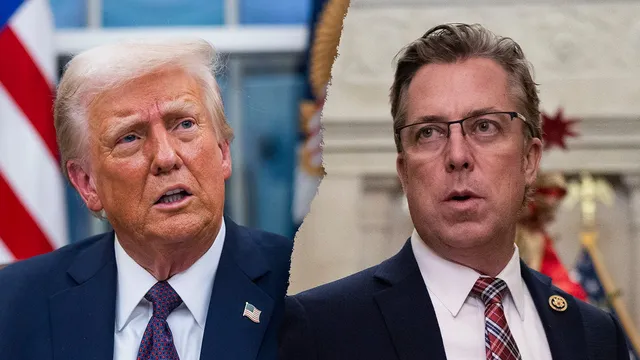
Rep. Andy Ogles pushes for Trump's third term eligibility after tax bill success
2025-07-03 14:39- Rep. Andy Ogles has been vocal about supporting changes to allow Donald Trump a third presidential term.
- The recent passing of a significant legislation has been framed as a transformative moment for the economy.
- Ogles advocates that the success of the bill under Trump's guidance showcases his eligibility for future leadership.
Express your sentiment!
Insights
In the United States, a Republican congressman from Tennessee, Andy Ogles, has made headlines after advocating for legislation aimed at extending Donald Trump's eligibility for a third term as President. This advocacy follows the passage of a significant piece of legislation dubbed the 'big, beautiful bill,' which was characterized by Ogles as historic for its anticipated positive impact on the economy. Ogles reflects on his recent hours spent with Trump at the White House, actively engaging in vote-wrangling efforts with Speaker of the House Mike Johnson. The legislation not only encapsulates tax cuts from the Trump administration's earlier policies but also aims to strengthen border security and raise the national debt limit by $5 trillion. Ogles asserted that the bill represents a crucial shift in American policy, challenging previous Democratic approaches by focusing on tax reductions for the working and middle classes. Furthermore, the bill seeks to enhance funding for national defense and immigration enforcement, echoing Trump's previous hardline stances. Despite the claims of the bill's supporters, critics, mainly from the Democratic Party, have labeled it as a significant tax break for the wealthy, potentially undermining beneficial programs for lower-income Americans. Ogles’s comments advocating for Trump’s third term have not only reignited discussions about term limits but also displayed a fervent alignment with Trump's policies and a rejection of the approaches taken during the past years of Democratic leadership. The debates in Congress surrounding this legislation were intense, involving numerous negotiations and strategic efforts to persuade holdout votes from within the Republican Party. Ogles's position illustrates the sentiment among a faction of GOP members who feel a return to Trump's leadership could provide the necessary direction to rectify current economic difficulties and reestablish a conservative agenda.
Contexts
Presidential term limits in the United States have evolved significantly over time, shaped by historical circumstances and the collective experiences of the nation. Initially, the U.S. Constitution did not impose any limits on the number of terms a president could serve. This lack of restrictions allowed George Washington to set the precedent of serving two terms, a decision that reflected his belief in the importance of avoiding excessive concentration of power within the executive branch. Washington's voluntary decision was followed by subsequent presidents until Franklin D. Roosevelt, who was elected to four terms during the tumultuous years of the Great Depression and World War II. His unprecedented tenure raised concerns about the implications of unlimited presidential power and led to calls for a constitutional amendment to formally limit presidential terms. In response to the growing consensus around the need for term limits, Congress proposed the 22nd Amendment to the Constitution in 1947, which was ratified by the states in 1951. This amendment specifically restricts an individual from being elected to the office of the President more than twice. The ratification of the 22nd Amendment marked a pivotal moment in U.S. constitutional law and governance, as it institutionalized the tradition of limited presidential service that had been established by Washington. The amendment underscores the principle that no single individual should hold power for an extended period, reflecting the founding fathers' concerns regarding tyranny and the preservation of democratic ideals. The debates surrounding the 22nd Amendment also highlighted differing perspectives on the balance of power within the government. Proponents argued that term limits would prevent the emergence of a dictatorship or authoritarian regime, while critics contended that such limitations could hinder the ability of experienced leaders to navigate complex national issues. Despite these contrasting views, the amendment has remained in place for decades, establishing a structural check on presidential authority and fostering the regular turnover of leadership within the executive branch. Today, the discussion surrounding presidential term limits continues to be relevant, especially as political landscapes evolve and new challenges emerge. While the 22nd Amendment has successfully enforced term limits for presidents, it also raises questions about its long-term implications and whether it truly serves the best interests of the electorate. As the nation reflects on its past and looks toward the future, the history of presidential term limits remains a vital aspect of understanding the balance between liberty, governance, and the democratic process.